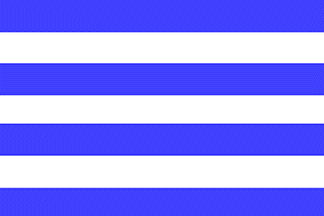![[coat of arms]](../images/r/ro)cluj.gif)

Last modified: 2015-07-28 by alex danes
Keywords: cluj | napoca | kolozsvar | klausenburg | romania | transylvania |
Links: FOTW homepage |
search |
disclaimer and copyright |
write us |
mirrors
See also:
Other sitesCluj-Napoca (in Hungarian Kolozsvár, in German Clausenburg) is a city in Cluj County of Romania (in the valley of Somes River in Transylvania). The city has got 328.602 inhabitants (74.900 (22,8%) Hungarians, 1992 census). The settlement as the second largest Hungarian community over the border is a cultural and political centre of the Transylvanian Hungarians.
The territory of the city is inhabited from Ages. Before the Roman troops arrived there was a Dacian fortress. 124-271 AC there was a Roman city - Napoca - of Dacia Province. Castle of Kolozs was found at the beginning of the 11th century by the Hungarian kings. The castle became a capital of Kolozs County (first mention of the county is from 1173). The city was devastated in 1242 by the Mongols. In 1260s King Stephen V. resettled the town with Saxonians. Royal Town from 1316 by King Charles I. In 1458 the settlement was a city with council (50 Saxons and 50 Hungarians). From 1552 to 1690 the city is part of the semi-independent Principality of Transylvania. From 1690 to 1703 the capital of Transylvania (under Habsburg rule). In 1791 the application "Supplex Libellus Valachorum" for more political right to the Rumanians was made here. 1790-1848 capital of the Grand Duchy of Transylvania. The Parliament of Transylvania in Kolozsvár (in Rumanian Cluj) decided the Union with Hungary on 30th May 1848. 1849-1867 part of Transylvania.
The settlement in 1910 was a city of the Kingdom of Hungary. Inhabitants in 1910: 60.808; 50.704 (83,4%) Hungarian, 7.562 (12,4%) Rumanian, 1.676 (2,8%) German and 866 (1,4%) other by mother tongue, 20.726 (34,1%) Calvinist, 19.021 (31,3%) Roman Catholic, 8.646.(14,2) Greek Catholic, 7.054 (11,6%) Jew, 2.007 (3,3%) Lutheran, 1946 (3,2%) Unitarian, 1338 (2,2%) Greek Ortodox and 70 (0,1%) other by religion. After the Rumanian Declaration of Alba Iulia about the Union with Romania the National Assembly of the Hungarians of Transylvania declarated the belonging to Hungary in Kolozsvár. From 1918/1920 (Romanian occupation / Treaty of Trianon) to 1940 (Second Decision in Vienna) part of the Kingdom of Romania. 1940-1944 part of Hungary. The Treaty of Paris reallocated it to Romania. The settlement was the capital of Cluj Region 1952-1968 and from 1968 capital of Cluj county. In 1974 City of Cluj has got the new name Cluj-Napoca to remember the ancient city, Napoca.
Famous Hungarian celebrities were born in Cluj: King Matthias Corvinus (1440-1490), king of Hungary, István Bocskay (1557-1606) Prince of Transylvania and János Bólyai mathematician (1802-1860). The city is very rich in historical buildings, sculptures from the centuries, there is the Transylvanian Hungarian National Pantheon and the seat of the Transylvanian Unitarian Church and the Transylvanian Reformed Church.
István Molnár, 9 December 2000
History of Cluj Napoca here: http://www.cjnet.ro/cj/istoric.html and http://www.debrecen.com/kolozsvar/kvar.html
István Molnár, 9 December 2000
located at http://www.cjnet.ro/eindex/index.html and http://www.ClujNapoca.ro/img/biacluj.gif
coat of arms of Cluj-Napoca. This is the official version from the 1990s
years. The coat of arms colours relate to the Romanian inhabitants, the
Roman soldier in the blue field relates to the Dacians and Roman
Legions and Napoca city, the monument (you can find in the High
Square of the city) relates to the Romanian heroes of the last
centuries.
István Molnár, 9 December 2000 and 9 January 2001
The
dragon is the Dacian flag Draco, as seen on
http://www.gk.ro/sarmizegetusa/eng/draco.htm, where it is described as "the standard of the ancient Dacian military. It had a wolf head with the mouth open, with a snake body, made out of bronze and it ended with some linen stripes. It was put on a rod and if held in the air while galloping, it made a whistling sound, due to the air which entered the wolf's mouth."
Ion Cionca, 28 February 2005
 by István Molnár, 9 December 2000
by István Molnár, 9 December 2000
Seven blue and white horizontal stripes
António Martins, 27 February 2001
This flag appears at Dr. Széll Sándor: Városaink neve, címere és
lobogója (1941) as "Kolozsvár, Kolozs Co.".
István Molnár, 9 December 2000
Historical Coat of Arms
Sripts from Napoca Municipium, Dacia Province, Roman Empire: http://www.ClujNapoca.ro/img/inscriptie1.gif
Seal of Kolozsvár (Cluswar), Kingdom of Hungary from the Middle Ages: http://www.ClujNapoca.ro/img/antica1.gif
Seal of Kolozsvár (Civitatis Coluswar), Kingdom of Hungary later Principality of Transylvania from the Middle Ages: http://www.ClujNapoca.ro/img/antica2.gif
Coat of Arms of Klausenburg City, Grand Duchy of Transylvania (till 1867), Kolozsvár City, Kingdom of Hungary (1867-1919 and 1940-1944):
Old CoA of Cluj / Kolozsvár / Klausenburg here: http://www.msci.memphis.edu/~matlakz/kolozsvar/index.html. The colours of the CoA same as the colours of the historical flag: blue and silver (white). The CoA relates to the castle of the city. This old CoA which was used to the communist era was a part of the CoA of Cluj-Napoca in 1980. This version was in use till 1920 and 1940-1944
István Molnár, 9 and 11 December 2000 and 19 January 2002
Coat of Arms of Cluj City, Kingdom of Romania (1920-1940):
located at http://www.ClujNapoca.ro/img/municipiucluj.gif
István Molnár, 9 January 2001
This version was in use 1920-1940
István Molnár, 19 January 2002
Coat of Arms of Cluj-Napoca City, Socialist Republic of Romania 1974-1989: http://www.ClujNapoca.ro/img/ceausescu.gif